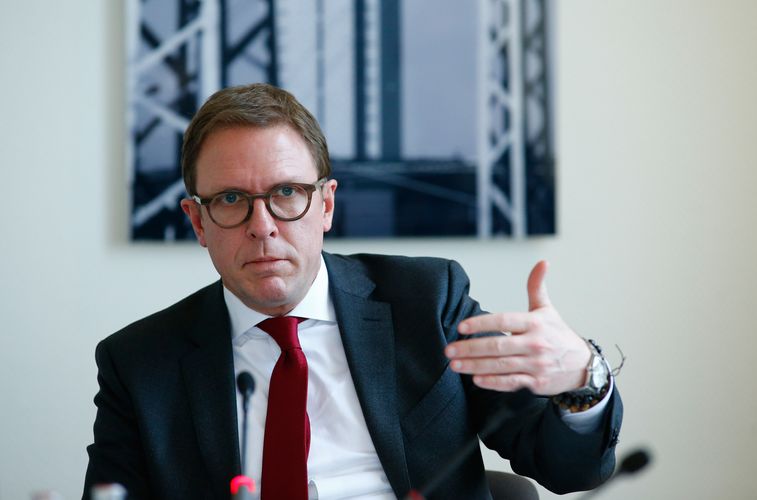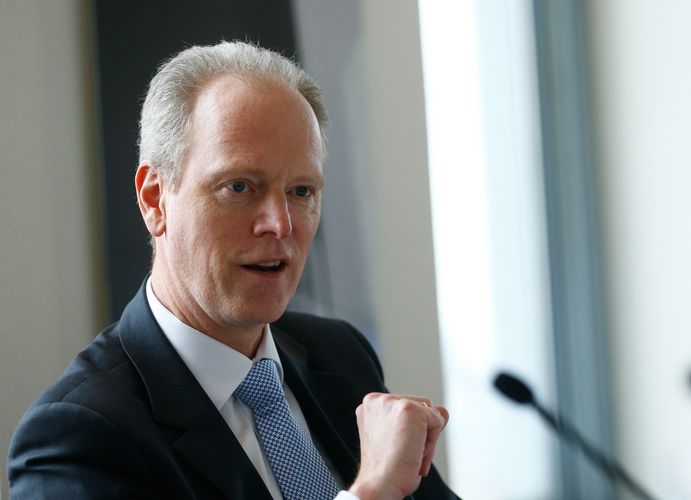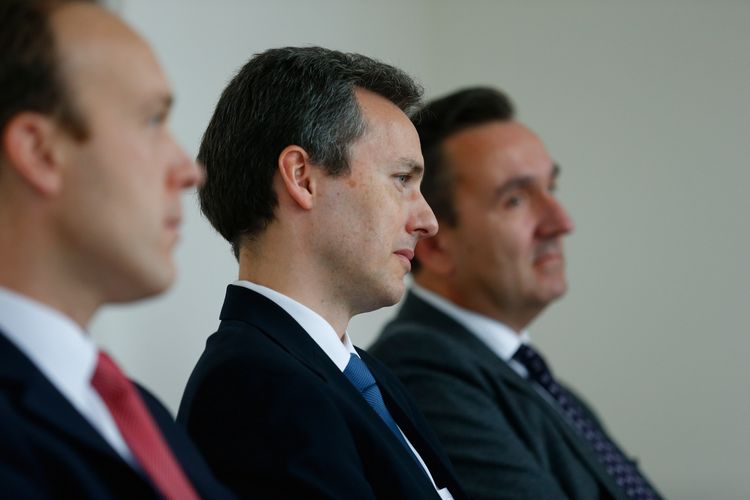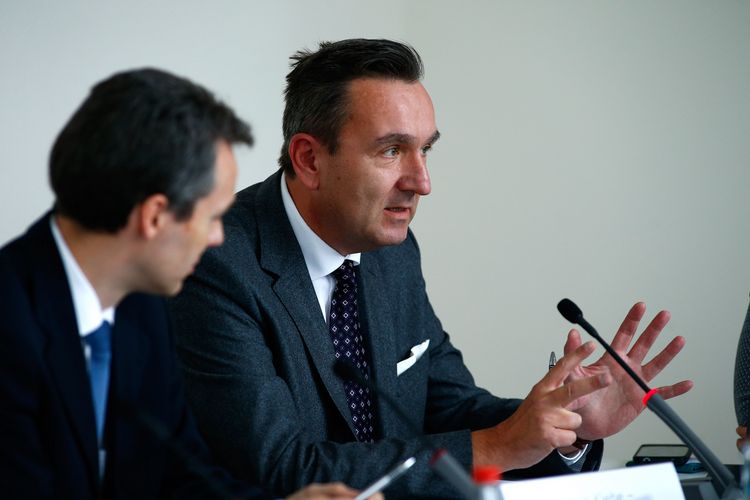IFR: Welcome everyone, and thank you in particular to vdp for sponsoring this event.
To open the discussion, let’s talk about the issuance trends we’ve seen so far this year. It has been a very strong start to the year, volume wise: I think we have seen €25.5bn issued so far. What are the market dynamics that are making it so favourable right now? And what have we seen in terms of trends?
Ralf Grossmann, head of covered bond origination at Societe Generale: It has indeed been quite a nice start of the year, which is usual for January in this market. We always have big volumes, investors are there, cash is available and issuers want to get out into the market early. So it definitely makes sense.
This year we might also see additional activity because of the regulatory uncertainty around the minimum requirement for own funds and eligible liabilities (MREL) – or senior non-preferred status. So some issuers decided to go ahead with their covered bonds first, because there are no uncertainties around that. Other deals will follow later on.
But it has been interesting to see the pattern emerging, where we see a very strong first week, with over €12bn. Then volumes shrank a bit but that was useful in preventing the indigestion we sometimes see in the market.
In terms of the new issue premiums, issuers have got away with very small premium. The average is around 2bp-4bp, which is quite reasonable for the benchmark market at that time of year. And deals have performed. Spreads have been tightening again this year, after they widened last year, which is a good sign and ensures appetite will remain strong in coming months.
IFR: Have you noticed any particular trends in terms of issuance, more activity at the short end or the long end, or has there been success across the curve?
Ralf Grossmann, SG: The pattern is much more spread across a broader maturity spectrum than we saw for much of last year. We have now basically seen everything from five to 20 years being covered in the new issue market and with good success.
I would also argue that, while yes we did have a strong start to the year, it was nothing really spectacular or uncommon. If there was anything really uncommon it was simply the fact that it started slightly earlier than usual. But that was basically because of how the weekends and holidays fell, which made it convenient for the primary market to kick-off very early. It is quite natural that we are running slightly ahead of the usual path. But it is only by a very slim margin.
We have seen a very solid issuance result but it’s by no means unusual.
IFR: Would you say it’s very similar to what we had last year?
Ralf Grossmann, SG: Exactly. We are currently only a tad ahead of the issuance path of last year, which is a solid result.
It’s not as spectacular to look at it from a volume perspective, but it is striking that so many banks are keen to front-load their issuance, rather than wait and see.
IFR: But the end of last year was tricky, right? There was a bit of a sell-off, when yields started to rise. So do you think that we had a bit of pent-up supply as well?
Ralf Grossmann, SG: Yes, there have been a couple of deals that were postponed from last year. But a lot of it is front-loading for this year. So far this year we have seen a €2.5bn triple-tranche deal from Credit Agricole, that’s the first one ever. We also had an inaugural deal from DBS in euros.
So while it is true that volumes have not been spectacular, we have already had some highlights, which is quite encouraging.
IFR: Neither Berlin Hyp or Deutsche Hypo has done a deal yet. Any reason why you’ve not decided to step into the market?
Bodo Winkler, head of investor relations and sales, Berlin Hyp: Yes, of course. Basically we don’t have that big a need for liquidity at the beginning of this year. Our first benchmark mortgage Pfandbrief maturity this year will only be in May.
We did a lot of funding last year and we don’t feel under pressure at all to make use of the beginning of the year. So this year we decided to first watch the market. When we think it’s appropriate to issue we will come with our first deal for this year. [It has since issued, on February 15]
It’s a very comfortable situation to be in, having time to pick your moment.
IFR: How much do you need to do this year?
Bodo Winkler, Berlin Hyp: In covered bonds, it will be around €2bn, pretty much in line with what we have done in recent years. Given the environment we are still in, we think this corresponds to three benchmark deals.
Juergen Klebe, head of funding and investor relations, Deutsche Hypo: It’s pretty much the same situation for us. In our case it is €2bn-€3bn, most likely. Liquidity-wise there is no urgency for us to do anything right now. We will wait for the right opportunity to issue. And we may think about other currencies than the euro. The British pound would be an option for us. So we have flexibility on currency and timing.
We don’t see spreads exploding. If the European Central Bank decided out of the blue to step out of the market, that could cause spreads to widen but that is a risk that everybody faces. But there is no pressure on us specifically as far as timing is concerned.
IFR: Would you say waiting last year paid off for you, in terms of funding level and demand?
Bodo Winkler, Berlin Hyp: The absolute funding level isn’t the most important parameter as long as you’re able to increase the spreads for lending in the end. Having a smooth environment for funding, where the market is receptive, is more important for us. All Berlin Hyp deals in 2016 were at least two times oversubscribed.
Juergen Klebe, Deutsche Hypo: I agree, it’s not about achieving one or two basis points, plus or minus, it’s always about for waiting for the right moment.
IFR: There must have been an evolution in terms of the German covered bond market? How has the spread changed?
Bodo Winkler, Berlin Hyp: They have certainly tightened again, relative to the end of last year when they widened a little bit. But I’m still not sure whether we will see the spreads we saw early last year again in the near future. At that time we saw certain banks coming to market with spread levels of minus 20bp or something, from what I remember. It will depend on what happens in the wider market environment, be that with all the elections we have coming up in Europe, or the possible tapering by the ECB, for example.
IFR: You think that might have been a once-in-a-lifetime thing?
Bodo Winkler, Berlin Hyp: Possibly.
Ralf Grossmann, SG: The German Pfandbrief market is always in a special situation in that respect because it has such a strong domestic buyer base, which is there in good and bad times. It means the funding window is usually open and the spreads do not move that much.
But then you never know. If you have a flight to quality later in the year the Pfandbrief market will benefit from that as well. So there may be some value in waiting a bit with benchmark issuance, maybe we will see those negative spread levels again. I agree it is quite unlikely but it is possible.
Another point is that some issuers see in the transition to the negative-yield environment an opportunity to issue benchmarks at the shorter end. It’s still a bit shaky right now but there’s a debate about whether it would be possible to launch a Pfandbrief benchmark at negative yield. We did it last year and I think it would work.
The question is would you like to do it again? How easy was the exercise? I think it worked quite well but in my discussions with issuers I get the impression they are a bit sceptical it would be easy to do it. It seems most people would prefer to have at least a bit of yield, at least 1bp yield, to get the deal done.
Bodo Winkler, Berlin Hyp: But it is a good thing that it is now possible to issue maturities that would not have been possible last year without risking a negative yield. Anyway, our experience when we did this, which was almost one year ago, was that it was not difficult at all. Strangely enough, the book was almost three times oversubscribed, with one of the highest proportions of non-domestic buyers we have had in a covered bond deal so far.
We didn’t see it as a risk to go with the negative yield because we were well prepared and did a lot of investor relations work before.
IFR: It must be a relief though, to see other parts of the market opening up again? As an issuer, do you prefer the short end or does it not matter?
Bodo Winkler, Berlin Hyp: No, it is always important for us that we meet the maturities of the assets in the covered pool. What we experienced during this low-yield environment is that borrowers tend to agree to longer-dated contracts, even in commercial real estate. In the past, five years was the norm, it was the most common maturity you would see on the asset side. This has now lengthened and in our case it is almost seven years, so quite a move.
It’s not rare to see 10 years any more in commercial real estate lending. That gives us more opportunities and more choice when it comes to choosing the right maturity for our Pfandbrief.
Juergen Klebe, Deutsche Hypo: It’s pretty much the same for us. Being active in commercial real estate means you tend to have funding needs between two and seven years. During the negative-yield environment two to three-year deals were nearly impossible, which got quite difficult at the end. But now the variety of maturities available is far better than it was last year.
I disagree with this view of the German Pfandbrief market as being a no-brainer. With the ECB buying programme in mind, all issuers, whether that is Berlin Hypo or us or other issuers, we are always on the road, meeting investors. Of course Pfandbriefe are a quality product but it is still important to promote them to investors. Even with the ECB in the background, you have to talk to investors to establish what they want and ensure they are on board with every maturity you want to issue.
IFR: How easy is it to attract international investors? It was mentioned earlier, how these deals can price very tight, and they tend to appeal more to a domestic investor base. How do you get around that?
Juergen Klebe, Deutsche Hypo: It’s as simple as visiting people. There is definite interest in German Pfandbriefe. We’ve recently been to Paris, an investor asked if we could visit so they could have a look at our credit; things like that tend to pay off in the end. The same is true for German investors as well; if you haven’t seen them for two years or longer it’s worth visiting them. That can help keep investors on board or bring them back on board.
IFR: You’ve mentioned sterling. We’ve seen actually a few German issuers go to the sterling market, what’s the attraction of that market?
Juergen Klebe, Deutsche Hypo: We at Deutsche Hypo do business out of our London branch so we have a natural need for sterling. That is pretty much the reason why we go to London. I will go to London in a week or two to get people on board as far as a possible transaction is concerned.
IFR: Is sterling attractive in terms of funding as well?
Juergen Klebe, Deutsche Hypo: Seen from a euro perspective, you most likely have to pay a little bit more on sterling transactions. Nevertheless, you need the original liquidity in British pounds so it’s worth issuing there, even if you have to pay an additional few basis points on it.
IFR: In the Pfandbrief market specifically have there been any stand-out trends in terms of volume?
Jens Tolckmitt, vdp: It was still consolidating last year. We expected consolidation to end at the beginning of the year, given the figures that we were provided by our members on planned issuance. In the end we ended up falling a bit short, mainly due to ECB actions and the ample liquidity available from other sources. That meant the overall market continued to consolidate. This year we have an estimated issuance of around €55bn, again based again on the figures provided by our members. Provided it works out this way, and there is no influence from other sources, we will have a positive net issuance at the end of the year. In that case market consolidation would at last have come to an end.
We have expected that for a number of years but if you look at the overall environment and the development of the market, there is always an explanation for why things don‘t happen the way expected at the start of the year. It may have to do with regulation, or the introduction of ECB supervision or something else. It is reasonable to believe consolidation would have ended earlier under normal circumstances.
Bodo Winkler, Berlin Hyp: If I remember correctly I think Germany was again one of the strongest, if not the strongest, country in terms of benchmark issuances. What you find in this country is this large variety of issuers. So there’s a variety of sources that all the Pfandbriefe come from. So I would expect this year Germany will again have a very strong year.
Ted Packmohr, head of financials and covered bond research, Commerzbank: The public markets have quite clearly benefited from falling demand for private placements, due to the low-yield environment. Private placements are a significant pillar of the German registered Pfandbrief market in the form of the registered segment, which is very prominent here in Germany. As this has declined, benchmark issuance has been stepped up.
So where in past years around 30% of overall Pfandbrief issuance came as benchmark deals, today around 60% of Pfandbriefe are being printed in benchmark format. Add to that the other public placements below benchmark size, the LCR €250m deals. So there’s much more emphasis on benchmarks these days, which means German Pfandbriefe remain prominent despite declining volumes.
Martin Lenhard, vice president and senior credit officer, Moodys: We also have smaller issuers that used to do unrated private placements approaching us because they are interested in a covered bond rating. They think they need this to get into the sub-benchmark segment, to be eligible for LCR treatment and ensure their issuance is attractive to investors. The number of small banks that have a covered bond rating is still small but at least there are signs of a growing interest because the private placement market no longer has the liquidity they need. Yields are simply too low for traditional investors in this market.
Juergen Klebe, Deutsche Hypo: You can also see this quite clearly in Austria, right? Many smaller Austrian banks, having become active in the public markets, moving into exactly that niche.
Jens Tolckmitt, vdp: Since 2012 benchmark Pfandbriefe have ranked number one in Europe in terms of transactions and since 2014 also in terms of volume. In 2009 or 2010 nobody would have expected that for the German Pfandbrief market. But, of course, it’s a very positive development.
IFR: Does the increasing prominence of public benchmarks make the market more vibrant in a way? Is that generating more investor interest, and increasing the attractiveness of Pfandbriefe as a product?
Jens Tolckmitt, vdp: I obviously have a clear perspective on the attractiveness of Pfandbriefe and I think there are a lot of elements to it. One is certainly its successful benchmark segment, which today perfectly meets the need of investors who no longer concentrate on €1bn issues when looking for liquidity.
The deep investor base itself also makes the market attractive. There is a certain confidence that once the ECB leaves the market, traditional investors base will return. And it still is a huge market, with a total volume of around €370bn and a mortgage segment of more than €200bn. So there are a lot of reasons why this market is so attractive, not only the benchmark size.
IFR: You mentioned LCR, are the bank treasuries still buying a lot of this product? Are they are large part of the investor base?
Ted Packmohr, Commerzbank: Bank treasuries have become an even more important part of this market. When considering the attractiveness of the product for different types of investors, the decline of the private placement market is particularly visible on the insurance side of the market. German insurance companies definitely have a declining exposure to covered bonds. Maybe some of their allocation has shifted to external mandates with asset managers but there is definitely less engagement.
This is only one of the reasons bank treasuries have become increasingly prominent. That makes it so important that covered bonds continue to receive preferential regulatory treatment, because it drives investment by bank treasuries into covered bonds. That means not only preferred risk-weighting but also ECB repo eligibility, LCR eligibility etc.
Juergen Klebe, Deutsche Hypo: I think the reason for the success of Pfandbriefe with maturities of around five years is that is where bank treasuries are particularly active. LCR drives bank treasuries into Pfandbriefe, especially benchmark Pfandbriefe. That really influences how issuers approach the market.
In our case pretty much 100% of our issuance comes in benchmarks and bigger issues north of €250m. We do not issue Pfandbriefe in private placement format at the moment because we do not need the long and ultra-long maturities that insurance companies tend to buy. That is why we issue 100% in benchmarks and big private placements.
To see the digital version of this roundtable, please click here
To purchase printed copies or a PDF of this report, please email gloria.balbastro@tr.co



